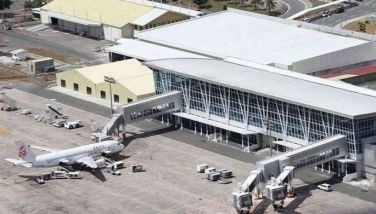Activa Parkinson’s Control Therapy: Moving back to life
December 29, 2005 | 12:00am
Thousands of lives around the world have been improved by the Activa Parkinson’s Control Therapy, a deep-brain stimulation therapy that is now available in the country through the Philippine Movement Disorder Surgery Center (Phil Move) at the Cardinal Santos Hospital in San Juan.
"Activa Parkinson’s Control Therapy has shown around 90 percent efficacy in restoring function in patients suffering from the disease. That is about eight to nine people out of 10 who achieve significant improvement in their ability to do normal and daily activities," said Dr. Jose Aguilar of Phil Move, a center that specializes in functional stereotactic procedures and is managed by doctors specializing in neurosurgery and neurology.
While it does not cure the disease (no cure has yet been discovered for Parkinson’s disease), the Activa Parkinson’s Control Therapy safely and noticeably suppresses Parkinson’s symptoms in patients.
It has already benefited countless individuals in Europe, Canada and Australia since 1995 and in the United States since 1997.
One of those whose life has been dramatically improved by the therapy is Michel Placeman, who was diagnosed with Parkinson’s disease in his mid-30s and was already severely incapacitated in his 50s.
"I was used to the tremor after years," he said. "But being unable to make any kind of movement for hours was like a nightmare."
Placeman then heard of the Activa Parkinson’s Therapy, which was then being pioneered in Europe in 1995. Hearing that it causes dramatic improvements, he then immediately availed himself of the therapy.
"Before Activa, I was an invalid. Now all the normal little things that make life a joy for me – using my computer, going shopping, exercising – are again accessible for me," he said.
According to Aguilar, patients like Michel suffer from abnormalities in structures deep within the brain that then cause the major symptoms of Parkinson’s disease such as tremors, rigidity, and slowness or lack of movement.
"One of these structures is the substantia nigra, which produces dopamine, a chemical essential for controlling normal movement and muscle function," he said.
"As the cells die and less and less dopamine is released, other structures of the motor circuit that process nerve signals are also affected and begin to act abnormally. It affects the motor circuit by virtually slowing it down, causing the symptoms of Parkinson’s disease to appear," he added.
When nerve signals are modulated by mild electrical stimulation such as that offered by the Activa Parkinson’s Control Therapy, the abnormal brain signals are blocked and more normal movement and function return.
Dr. Theodor Vesagas advised that patients who wish to undergo the Activa Parkinson’s Control Therapy should thoroughly discuss the procedure with their doctors.
"Their neurologist and neurosurgeon will assess their symptoms and their suitability for the implant procedure," he said.
The implanted components of the Activa Parkinson’s Control Therapy include a lead and neurostimulator, which are connected by an extension wire.
The lead is a thin insulated wire with four electrodes at the tip that is implanted deep within the structures of the brain, while the neurostimulator is a small, sealed, titanium and plastic device with a battery that produces the mild electrical pulses needed for stimulation. The extension consists of a thin, insulated wire that is threaded under the skin.
The implant procedure of the Activa Parkinson’s Control Therapy also involves the use of sophisticated imaging equipment like computed tomography (CT) scans and magnetic resonance imaging (MRI) machines as well as a test period of stimulation to ensure that the lead is correctly placed.
Vesagas added that patients need to undergo programming visits as many times during the first six months of implantation and follow-up visits as frequently as every six months as there will be multiple adjustments in the stimulator and in the medications.
To learn more about DBS and the Activa Parkinson’s Control Therapy, contact the Philippine Movement Disorder Surgery Center at 726-0776 or 727-7653.
"Activa Parkinson’s Control Therapy has shown around 90 percent efficacy in restoring function in patients suffering from the disease. That is about eight to nine people out of 10 who achieve significant improvement in their ability to do normal and daily activities," said Dr. Jose Aguilar of Phil Move, a center that specializes in functional stereotactic procedures and is managed by doctors specializing in neurosurgery and neurology.
While it does not cure the disease (no cure has yet been discovered for Parkinson’s disease), the Activa Parkinson’s Control Therapy safely and noticeably suppresses Parkinson’s symptoms in patients.
It has already benefited countless individuals in Europe, Canada and Australia since 1995 and in the United States since 1997.
One of those whose life has been dramatically improved by the therapy is Michel Placeman, who was diagnosed with Parkinson’s disease in his mid-30s and was already severely incapacitated in his 50s.
"I was used to the tremor after years," he said. "But being unable to make any kind of movement for hours was like a nightmare."
Placeman then heard of the Activa Parkinson’s Therapy, which was then being pioneered in Europe in 1995. Hearing that it causes dramatic improvements, he then immediately availed himself of the therapy.
"Before Activa, I was an invalid. Now all the normal little things that make life a joy for me – using my computer, going shopping, exercising – are again accessible for me," he said.
According to Aguilar, patients like Michel suffer from abnormalities in structures deep within the brain that then cause the major symptoms of Parkinson’s disease such as tremors, rigidity, and slowness or lack of movement.
"One of these structures is the substantia nigra, which produces dopamine, a chemical essential for controlling normal movement and muscle function," he said.
"As the cells die and less and less dopamine is released, other structures of the motor circuit that process nerve signals are also affected and begin to act abnormally. It affects the motor circuit by virtually slowing it down, causing the symptoms of Parkinson’s disease to appear," he added.
When nerve signals are modulated by mild electrical stimulation such as that offered by the Activa Parkinson’s Control Therapy, the abnormal brain signals are blocked and more normal movement and function return.
Dr. Theodor Vesagas advised that patients who wish to undergo the Activa Parkinson’s Control Therapy should thoroughly discuss the procedure with their doctors.
"Their neurologist and neurosurgeon will assess their symptoms and their suitability for the implant procedure," he said.
The implanted components of the Activa Parkinson’s Control Therapy include a lead and neurostimulator, which are connected by an extension wire.
The lead is a thin insulated wire with four electrodes at the tip that is implanted deep within the structures of the brain, while the neurostimulator is a small, sealed, titanium and plastic device with a battery that produces the mild electrical pulses needed for stimulation. The extension consists of a thin, insulated wire that is threaded under the skin.
The implant procedure of the Activa Parkinson’s Control Therapy also involves the use of sophisticated imaging equipment like computed tomography (CT) scans and magnetic resonance imaging (MRI) machines as well as a test period of stimulation to ensure that the lead is correctly placed.
Vesagas added that patients need to undergo programming visits as many times during the first six months of implantation and follow-up visits as frequently as every six months as there will be multiple adjustments in the stimulator and in the medications.
To learn more about DBS and the Activa Parkinson’s Control Therapy, contact the Philippine Movement Disorder Surgery Center at 726-0776 or 727-7653.
BrandSpace Articles
<
>
- Latest
Latest
Latest
October 24, 2024 - 11:20am
October 24, 2024 - 11:20am
October 14, 2024 - 11:00am
October 14, 2024 - 11:00am
October 11, 2024 - 12:49pm
October 11, 2024 - 12:49pm
September 30, 2024 - 8:00am
September 30, 2024 - 8:00am
September 26, 2024 - 2:00pm
September 26, 2024 - 2:00pm
September 3, 2024 - 1:00pm
September 3, 2024 - 1:00pm
Recommended






























